We’ve been opening doors and unlocking devices using our fingerprints, faces, voices, and irises for some time now.
Biometrics (the use of a person’s physical characteristics) that can verify identity are widely used to access secure services like from a bank, for immigration, border control and airport security, as well to use our favourite gadgets and digital devices.
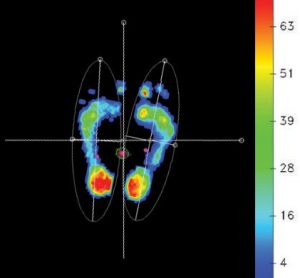
Heat maps of human footprints and gait pattern analysis can be used to provide positive identification of an individual.
Now, biometrics are taking the next step: the development of a new technology for security and surveillance based on analysis of an individual’s footsteps to obtain positive identification. A unique, pressure-sensitive smart flooring that can be used to identify individuals or track groups walking upon it is being developed here in Canada.
Erik Scheme, the associate director of the University of New Brunswick’s Institute of Biomedical Engineering, and his advanced technologies research team are conducting developmental research on the next step in biometric security – they’re working with other research and technology experts from UNB, CyberNB and Prince Edward Island-based Stepscan Technologies Inc. to build, test, validate, and improve security applications with the new technology.
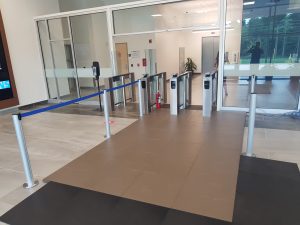
Pressure-sensitive electronic tiles from Stepscan Technologies have been installed for some real-world evaluation and validation of the new biometric system.
High-resolution, pressure-sensitive electronic tiles from Stepscan Technologies have been installed in the research lab at the university and in the Cyber Centre at Fredericton’s Knowledge Park for some real-world evaluation and validation.
(The Cyber Centre, a multi-tenant Level 2 secure building, is an advanced Canadian facility for cyber-defence and critical infrastructure protection; CyberNB, based in the Centre, is a cyber-security organization that supports collaboration across industry, government and research organizations.)
Data collected from the installed Stepscan tiles are used to generate a pixel-by-pixel heat distribution map showing the pressure points of someone’s feet as they walk over the sensor-packed surface; analysis of the map can be used to verify a user’s identity, along with the building’s existing security measures.
Each of our walks is apparently very unique, difficult to imitate or conceal, and therefore useful in verifying identity.
Already in use in a long-term seniors’ health care context, Bluetooth-enabled continuous gait monitoring technology from Stepscan Technologies is used to identify a person’s individual walking patterns. Healthcare providers can monitor a patient in real-time with automatic footprint detection and seamless data collection, and then provide personalized care based on their gait data.
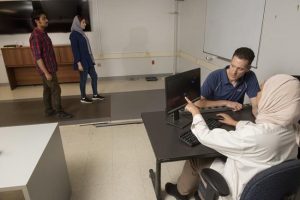
Gait analysis at UNB; gait is the specific way a person moves while walking, based on physical biology and learned movement.
Gait is the specific way a person moves while walking, based on physical biology and learned movement. An individual’s muscle and joint movements affect the way his or her feet touch the ground with every step they take. Effective tracking technology collects detailed statistics about the steps in time and space, including different pressure points and distributions; foot/floor interactions; and sway/balance factors, among other parameters.
“My team at UNB uses machine learning to better understand, assess, or control human movement and health,” Dr. Scheme explained. “This first-of-its-kind project is an exciting opportunity to apply our expertise in the real world to validate and improve Stepscan’s novel, touchless biometric solution.”
Dr. Scheme partnered with Stepscan’s research and development lead, Dr. Patrick Connor, through an NSERC-supported postdoctoral fellowship, on this new application. Student assistants work on the gait project with the help of the non-profit research organization Mitacs.
UNB is also home to the Andrew and Marjorie McCain Human Performance Lab, a top advanced motion analysis lab in North America. Combined expertise in machine learning, human-machine interaction, gait analysis and biometrics, as well as access to the top-class research facilities for data collection, analysis, and prototype testing, has been crucial to the testing and development of modular, pressure-sensitive flooring that can capture enough data from natural footsteps for biometric security applications.
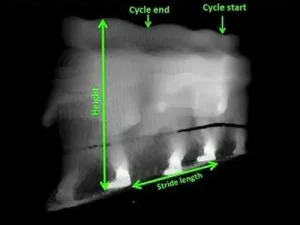
Researchers at the National Physical Laboratory in the U.K. have developed a new technology that identifies people by analyzing their gait signature. This is the “gait cycle,” which is used to generate a gait signature. YouTube/NPLdigital.
And while technologists and researchers in Canada are looking at how we walk from the ground up, as it were, elsewhere how we walk more often gets a top-down view for identification purposes, based on video cameras and gait analysis software.
In the U.K., researchers at the National Physical Laboratory (NPL) and their partners at the Centre for Advanced Software Technology and BAE Systems have developed a new technology that can identify people by analyzing their gait signature, or specific way of walking, as captured by CCTV security cameras.
The system combines computer models of an area under surveillance with live camera feeds that capture a person’s gait signature at certain points, checks where that person has been in the area, and display the results on a central computer.
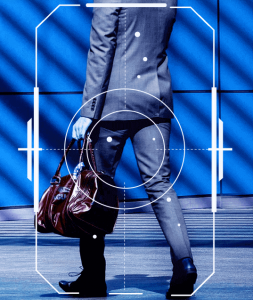
Watrix uses gait recognition, big data analysis of captured video, and biometric software for real-time identification of individuals in mega-city size deployments.
In China, a company called Watrix uses gait recognition, big data analysis of captured video, and biometric software for real-time identification of individuals in mega-city size deployments. Its deep-learning software analyzes surveillance video to detect a person’s walking movement; the company claims 94 per cent accuracy, saying the system can identify people up to 50 metres away, even with their back turned and their face covered.
Back at the University of New Brunswick, Scheme and the other research and technology experts from UNB, CyberNB and Stepscan Technologies describe how the “heel-to-toe data” they are capturing will be used to make 3-D models of people walking across the smart tiles. They say that deep learning techniques can indeed identify individuals based on gait, regardless of footwear worn, whether they are carrying heavy objects or even walking in a “distracted” way (yes, a reference to the Ministry of Silly Walks is definitely needed here!).
The UNB team intends to build a huge data set and make it public to support further research on gait analysis as a new biometric identification option.
Existing biometric systems have faced some adoption challenges, as controversies erupt over its use. Class action litigation is underway regarding the collection and use of data from biometric devices, and some government agencies want to ban their use outright.
So the development team at UNB had to be very careful with its system and collected data. The Cyber Centre employees who walk over the smart tiles as part of the research project had given consent ahead of time. A second group of users, involved in more sophisticated assessments that created what can be even more potentially personally identifying walk assessments, gave permission for data collection as they walked barefoot, in specific shoes or while carrying a backpack or briefcase.
Collected data is de-identified, stripped of personal information, and used as part of an anonymous dataset. Even so, for further use and eventual roll-out of such technology, companies must consider existing guidelines, laws, and other regulations.
Canada’s privacy commissioner, for example, says anyone or any company collecting sensitive information, including biometric data, should get meaningful consent first.
Before taking another step.
-30-



